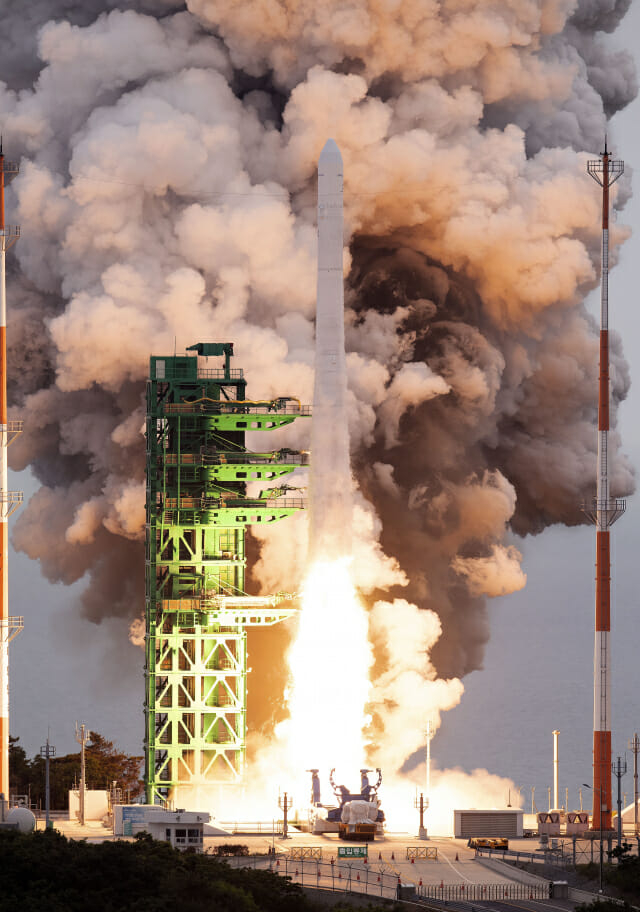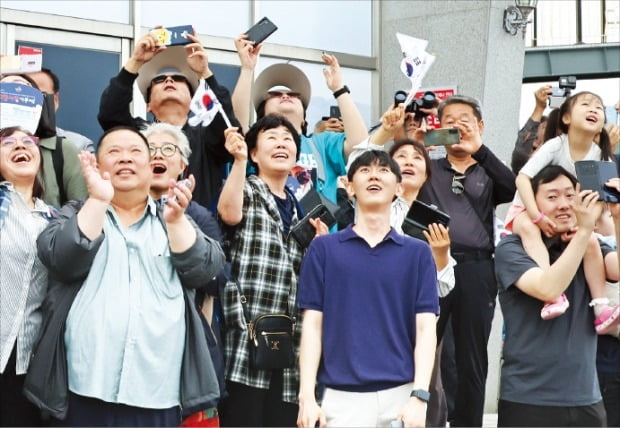Aerospace & Defense
S.Korea succeeds in 3rd launch of homegrown rocket Nuri
It also marks the first time for Korea to send satellites for commercial use into orbit
By May 25, 2023 (Gmt+09:00)
3
Min read
Most Read
LG Chem to sell water filter business to Glenwood PE for $692 million


KT&G eyes overseas M&A after rejecting activist fund's offer


Kyobo Life poised to buy Japan’s SBI Group-owned savings bank


StockX in merger talks with Naver’s online reseller Kream


Meritz backs half of ex-manager’s $210 mn hedge fund



The Korean Satellite Launch Vehicle Two (KSLV-II), nicknamed Nuri, lifted off into space at 6:24 p.m. local time from the launch pad at Naro Space Center in Goheung, South Jeolla Province, 473 km south of Seoul.
Engineers of state-run Korea Aerospace Research Institute (KARI) fixed problems with software by modifying commands until 5 a.m. on May 25. They found technical issues in communications between the programmable logic controller (PLC) for the rocket launch and valves for lowering the pressure of liquid helium the previous day.
The engineers started inspecting the vehicle’s airframe after the retrial decision at 11:00 a.m. by the launch management committee, which oversees the entire process. The experts completed the injection of fuel and oxidizer around 5:00 p.m.
Nuri blasted off on time as a 10-minute countdown ended, powered by hyperbaric pressure of 3,500 degrees Celsius gases emitted from the vehicle’s first section. The pressure soared to 60 times atmospheric, and 1.8 tons of coolant per second was pumped into the launch pad to cool down the temperature.
Nuri reached an altitude of 66 kilometers (km), 123 seconds after launch, and separated its first section. Then, the payload fairing that protects satellites and the rocket’s second section were separated.
As the space rocket reached an altitude of 550 km, 783 seconds after lift-off, it released Next Generation Small Satellite 2 (NEXTSat-2), the major payload satellite. KARI has confirmed that the rocket has released other six satellites; it is inspecting if the remaining one has been completely released.
The rocket flew for 18 minutes and 58 seconds as scheduled. After analyzing the flight data for 40 minutes, KARI officially announced the launch was successful.
At 7:07 p.m., King Sejong Station, Korea’s research station in western Antarctica, received NEXTSat-2’s beacon signal that regularly signifies the satellite’s presence. KARI is tracking the other satellites’ status.

LOCALLY DEVELOPED WITH PRIVATE COMPANIES
Korea's status as an aerospace powerhouse has been enhanced with the successful third launch. In the second test launch in June 2022, the country became one of the world's seven nations including the US, Russia, China, Japan, the European Union and India, to have launched satellites of at least 1 ton with their own technology.
The third launch carried NEXTSat-2, developed by Korea Advanced Institute of Science & Technology (KAIST), and seven cube-shaped satellites (cubesats), produced by local tech firms Justek Inc., Lumir Inc. and Kairospace Co., and Korea Astronomy & Space Science Institute.
It marked the first time that Nuri has sent a satellite for commercial use into orbit. The rocket carried a dummy satellite in its first test launch in October 2021, and in the second test launch last year, it loaded a dummy satellite and four cubesats for performance verification.
The launch on Thursday also marked the first time that a private company has led in the development and manufacture of the rocket, jointly with KARI.
Hanwha Aerospace Co., the aircraft engine parts-making unit of Hanwha Group, was designated by the state-run institute to upgrade Korea’s space projectile last year.
Under the deal, Hanwha and KARI will make three Nuri rockets between 2023 and 2027 and launch them four times, including the one blasted off on May 25. Hanwha will also acquire technologies related to the operation and launch of Nuri from KARI.
(Updated with the satellites' status)
Write to Jin-Won Kim at jin1@hankyung.com
Jihyun Kim edited this article.
More to Read
-
 Aerospace & DefenseS.Korean space rocket Nuri launch postponed due to technical issues
Aerospace & DefenseS.Korean space rocket Nuri launch postponed due to technical issuesMay 24, 2023 (Gmt+09:00)
1 Min read -
 Aerospace & DefenseS.Korea sets Nuri space rocket’s third launch on May 24
Aerospace & DefenseS.Korea sets Nuri space rocket’s third launch on May 24Apr 11, 2023 (Gmt+09:00)
2 Min read -
 Aerospace & DefenseHanwha Aerospace to launch 4 more Nuri rockets under $220 mn project
Aerospace & DefenseHanwha Aerospace to launch 4 more Nuri rockets under $220 mn projectDec 02, 2022 (Gmt+09:00)
2 Min read -
 Aerospace & DefenseS.Korea ushers in new space era with rocket launch success
Aerospace & DefenseS.Korea ushers in new space era with rocket launch successJun 21, 2022 (Gmt+09:00)
3 Min read
Comment 0
LOG IN


